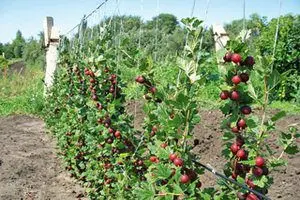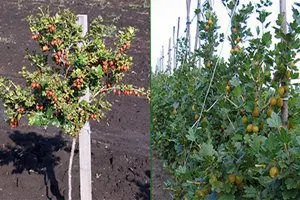Contents
Gooseberry is a shrubby berry crop of the family of the same name. The traditions of the cultivation of this berry in Russia have more than one century. In ancient Rus’, gooseberries were known as “bersen”. This is where Bersenevskaya embankment along the Moskva River takes its name. According to one of the toponymic versions, gooseberry plantations were located near this place. The wide distribution of gooseberries in Rus’ led to the fact that outside of our country they began to call it “Russian cherry plum”.
Gooseberry is a horticultural crop successfully cultivated in all regions of Russia. The plant is characterized by strong growth, its fruit is a drupe berry with excellent taste. The bush shows stable fruiting from the third year of life. The first harvest does not reveal all the possibilities of the variety; over the years, the number of berries increases and can be quite impressive.
Composition and calorie content
Calories 44 KKal
- Fats:
0,2 g
- Proteins:
1,0 g
- Carbohydrates:
12,0 g
- Water:
86,4 g
- Ash:
0,4 g
- Cellulose:
3,4 g
Vitamins | Quantity | % RDN |
Vitamin C (ascorbic acid) | 27,7 mg | 40% |
Vitamin B4 (choline) | 42,1 mg | 8% |
Vitamin K | 7,8 mcg | 7% |
Minerals (in 100 g): | Quantity | %RDN |
Silicon | 12 mg | 40% |
Rubidium | 193 mcg | 19% |
Molybdenum | 12 mcg | 17% |
Bor | 11 mcg | 16% |
Manganese | 140-450 μg | 14% |
Copper | 70-130 μg | 10% |
Cobalt | 0,9 mcg | 9% |
potassium | 198 mg | 8% |
Full chemical composition ➤
Other important connections:
Phytosterols — 7 mg (12,7% of RDI)
Purine — 8 mg (6,7% of RDI)
Oxalic acid — 66 mg (16,7% of RDI)
The benefits of gooseberries
Gooseberries are considered medicinal, they are part of many products and dishes recommended for dietary nutrition. Recipes with gooseberries appear in both folk and modern medicine.
Useful properties and application of gooseberries:
Prevention of chronic constipation;
Treatment of anemia and nosebleeds;
Treatment of diseases of the oral mucosa;
Normalization of blood pressure;
Prevention of the appearance of tumors;
Treatment of diseases of the urinary system.
Planting gooseberry seedlings
The main requirements for the site for planting this berry crop are a flat area or a small slope, protected from the prevailing winds. In a high area, seedlings often freeze slightly, as it is difficult to save snow there to cover the bushes. Low areas are usually too wet, where gooseberries will be constantly affected by fungal diseases.
Photo caption: The best time to plant gooseberries is autumn, in the middle lane it is the end of September, October
Before planting seedlings, soil preparation is carried out.
It is carefully dug up to a depth of at least 30 cm, fertilizers are applied:
300 g of complex fertilizer for each bush;
Up to 10 kg of compost or humus per planting hole.
One-two-year-old seedlings should have a developed root system. They are planted according to the scheme 1,5×1,5 m. When planting, you need to ensure that the root neck of the seedling is buried in the soil by at least 5-6 cm. After planting, the young plant is watered abundantly, the shoots are cut, leaving 4 -6 buds, lightly spud.
The soil under the seedling should always be loose and free from weeds. The first loosening is carried out in early spring after the snow melts.
Loosening depth:
Under the bushes – 6-8 cm;
Between the rows – 10-12 cm.
Shrub plantings need regular fertilization. If the planting pit was well filled with potash-phosphorus fertilizers, it is not necessary to apply them in the first 3 years.
Gooseberry fertilizer:
Nitrogen fertilizers for young seedlings – 10 g of urea per m2;
Nitrogen fertilizers for fruit-bearing bushes – 30-40 g of urea per m2;
Organics – 10 kg annually for each bush;
Full complex fertilizer – in the fall every 2-3 years, 150 g per bush.
Growing of gooseberry
In the first 2-3 years, the soil between the rows in the area occupied by a young berry grower is used for growing vegetables. They are looked after, and with the end of the growing season, the soil is cultivated by deep digging. The aisles on a fruit-bearing gooseberry plantation are kept clean of weeds and other plants, digging up the soil in spring and autumn. At the same time, mineral fertilizers are applied.
Gooseberries tolerate a slight lack of watering, however, in dry seasons, they need irrigation. Soil moisture should not fall below 70-75%.
Gooseberry watering regimen:
The first watering – after flowering, during the growth of berries (the first decade of May).
The second watering – during the pouring of berries (1-2 decade of June).
The third and subsequent – as needed, with a consumption of 40-50 liters per plant.
Moisture-charging watering – from late September to early October.
Simultaneously with the autumn moisture-charging irrigation, full mineral fertilizer (up to 150 g per bush) and organic matter (5-6 kg) are applied. Gooseberries are watered along the grooves. Their optimal depth is 10-15 cm, they should be located at a distance of 50 cm from the bush.
Reproduction of gooseberry by horizontal layers
If you wish, you can independently provide your garden with a sufficient amount of gooseberry planting material, as it takes root easily.
Types of layers:
vertical,
horizontal,
Arcuate.
For propagation by horizontal layering, grooves are prepared in advance in the projection of the bush. Strong annual branches are laid out in them, bent to the soil, fixed with wire pins. Soon sprouting green shoots will appear from the ground. They are spudded upon reaching a length of 10 cm, keep the soil moist. In autumn, young plants are separated from the mother liquor and planted in a permanent place. This method is considered the simplest, it is most common among gardeners.
Planting gooseberries on a trellis

For growing gooseberries on a trellis, tall varieties should be selected that do not give a large number of small branching or zero shoots. It is desirable that they have large, brightly colored berries.
First you need to build a trellis, which is supported by pipes made of plastic or iron, reinforced concrete or wooden poles with a length of at least 2 meters. They are pre-treated against corrosion, dug into the ground, and, if necessary, concreted. In long rows, additional supports are installed. 3 rows of galvanized wire are pulled over the entire structure, the distance between the rows is about 50 cm.
Gooseberry seedlings are planted along the trellis at a distance of at least 1 m from each other. Each seedling should have 4 branches extending from the root. They are tied to the bottom wire, fan-shaped. Subsequently, the branches of the seedling are directed upwards. Since the outer shoots may lag behind in growth due to a large deviation from the center of the bush, they are cut more strongly. Significant pruning stimulates high shoot formation and bud alertness.
With further care for the gooseberry, branches older than 6 years are cut into a ring, replacing them with young lateral shoots of this branch. With a shortage of shoots, they are replaced by reserve zero branches.
How to cut a standard gooseberry?

Some gardeners, experimenting, tried to grow gooseberries in the form of a stem culture. However, these attempts were unsuccessful for a long time, since heavy pruning led to thickening of the shoots and a drop in yield. The way out was the grafting of gooseberries on golden currants.
The term of the operation is the beginning of sap flow, which falls in the middle lane in the first decade of April. Grafting method – split. The gooseberry stalk is prepared in advance, storing it in a cool place so as not to provoke sap flow. The rootstock of the currant is split and the stalk is placed in it. If the stock is thicker than the scion, the stalk is shifted to one side, combining the cambium layer of the scion and the rootstock. The graft is wrapped with PVC film, the cut on the handle is coated with pitch.
The shoots that have appeared from the buds of the gooseberry cutting are sent to the place where it is necessary to form a bole. All other shoots at the base are cut into a ring.
When pruning a standard plant, the central branch is shortened, the rest are cut in accordance with it, giving the plant the desired shape. On each branch, 4 branches up to 20 cm high are left. Old or frozen branches are replaced with new ones. Further care consists in rejuvenation, thinning the bush, sanitary cleaning and stimulation of branching.
Harvesting
As soon as the berries acquire a characteristic color for the variety and soften somewhat, they begin to be harvested. Delay in harvesting leads to overripe fruit and crop failure. The picking of berries is carried out at the same time, sorting them into ripe and unripe specimens. Compotes, jelly, juices with pulp are made from ripe berries, they are used for dessert, wine is prepared. Unripe berries are used for jams and preserves. According to radiologists, unripe berries contribute to the removal of radionuclides from the body.
In order to easily pick the thorny gooseberries, various devices are used.









